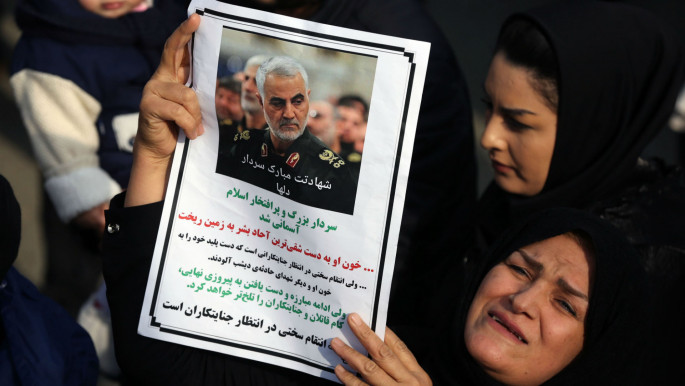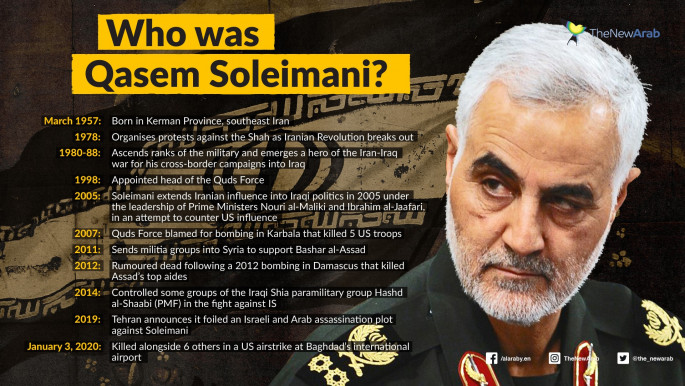'Operation Martyr Soleimani': Iran's missile strike against US in Iraq was more symbolic than lethal
In the early hours of Wednesday, January 8, Iran fired an estimated ten Fateh-313 missiles at Ain al-Asad military base in Iraq's Anbar province.
The Fateh-313 is a solid-fuel short-range ballistic missile developed from Iran's Fateh-110 series of missiles.
According to military aviation expert Tom Cooper, eight of the Fateh-313 missiles struck between the airbase's runways, two of which failed to detonate, and the other two missed their targets altogether, landing in a town near Anbar's provincial capital Ramadi.
The missiles that impacted reportedly caused some damage to the base's control tower and some US aircraft parked there, likely unmanned Reaper drones.
Initial post-strike satellite images show substantial damage, mostly on the eastern side of the base.
Iran also fired at least five Qiam-1 ballistic missiles at Iraqi Kurdistan's Erbil International Airport, which hosts US military forces.
 |
|
| Read also: Read also: The significance of Qasem Soleimani's assassination |
One was reportedly shot down while the others missed their targets altogether, possibly as a result of malfunctions.
The Qiam-1, which is liquid-fuelled and boasts a separable warhead, has demonstrated shortcomings in the recent past.
For example, when Iran fired missiles at the Islamic State group in eastern Syria near the border town of Abu Kamal back in October 2018, two Qiam-1 missiles crashed inside Iran mere seconds after takeoff.
Given the fact there were no reported casualties, it's likely that US personnel at Ain al-Asad military base had some forewarning of the attack and were consequently able to take necessary precautions.
It's also likely that Iran purposely aimed its missiles at parts of the bases where they were less likely to cause any US casualties.
By doing so, Tehran lived-up to its vow of retaliating and potentially won a propaganda coup domestically by boosting morale among the IRGC's rank-and-file in the wake of Soleimani's assassination. And it did so while avoiding escalation with the US that killing scores of its soldiers would undoubtedly have brought about.
 |
Iran purposely aimed its missiles at parts of the bases where they were less likely to cause any US casualties |  |
US President Donald Trump's initial reaction strongly suggests he wants to avoid any further escalation. Also, according to CNN, multiple Trump administration officials believe that Iran intentionally avoided harming any American personnel.
| | |
Iranian Foreign Minister Javad Zarif also tweeted that Iran "concluded measures in self-defence" and that Tehran does "not seek escalation or war."
Iran called Wednesday's operation 'Martyr Soleimani' and launched it the same time as the US drone strike that killed Soleimani on January 3.
The missile attacks followed months of increasing US-Iran tensions in Iraq that dramatically escalated in late December.
On December 27, the Iran-backed Kataib Hezbollah Iraqi militia fired rockets at the K1 military base in Kirkuk killing a US civilian contractor and wounding US troops. The US responded by killing 25 Kataib Hezbollah militiamen in five airstrikes, three in Iraq and two in Syria, on December 29.
Supporters of the militia carried out a violent protest at the US embassy compound in Baghdad on December 31 and demanded the expulsion of US troops.
Then, on January 3, a US drone killed Soleimani and Kataib Hezbollah leader Abu Mahdi al-Muhandis as their convoy left Baghdad International Airport. The US claimed Soleimani was preparing to carry out more attacks against Americans in Iraq.
 |
|
Tehran immediately vowed retaliation against the US and, on Wednesday morning, launched Operation Martyr Soleimani.
It's unlikely Iran will launch more direct missile strikes of this kind unless there is another major escalation with the US.
On the other hand, it will likely continue supporting and endorsing Kataib Hezbollah and other Iraqi militia attacks targeting US troops as it simultaneously exerts pressure on Iraq to remove those troops altogether.
Following the missile strikes, Iranian President Hassan Rouhani tweeted that, "Our final answer to his [Soleimani's] assassination will be to kick all US forces out of the region."
Iran's Supreme Leader Ayatollah Ali Khamenei said the missile strikes were "a slap in the face" to the US and also called for an end to its presence in the region.
Wednesday was not the first time Iran fired ballistic missiles into Iraq since the Iran-Iraq War in the 1980s, far from it.
 |
In recent years, Iran has improved many of its missiles by extending their operational range and enhancing their accuracy |  |
Throughout the late 1990s and early 2000s, Tehran fired missiles at bases belonging to the People's Mujahedin of Iran [MEK] militant group, which Saddam Hussein hosted.
More recently, on September 8, 2018, Tehran fired seven Fateh-110 missiles at the headquarters of Iranian Kurdish opposition groups in the town of Koya in Iraqi Kurdistan. The strike killed 18 people, injured 50, and demonstrated just how precise Iran's missiles have become.
In recent years, Iran has improved many of its missiles by extending their operational range and enhancing their accuracy.
The Iranian regime has invested heavily in its missile arsenal and greatly values it since it gives the Islamic Republic the ability to deter potential adversaries as well as threaten rival states and groups far beyond its own frontiers.
Paul Iddon is a freelance journalist based in Erbil, Iraqi Kurdistan, who writes about Middle East affairs.
Follow him on Twitter: @pauliddon





 Follow the Middle East's top stories in English at The New Arab on Google News
Follow the Middle East's top stories in English at The New Arab on Google News


